Goat Rocks 2013
by Mike Thompson, 9/4/2013
Friday, 8/16/2013: We left Craig's McKibben's house in Seattle at 5:30 AM. Had breadfast at a restaurant/bar in Packwood, and twenty miles of gravel road later we were at the Snowgrass Flats trailhead. We were on our way up the trail with our packs on our backs by 10:00 AM. Upon reaching Snowgrass Flats we stepped out of the forest and into a sea of beautiful wildflowers, which surrounded us along the remainder of the trail to Old Snowy. Every summer that I come to this gorgeous place I find it awash in flowers.
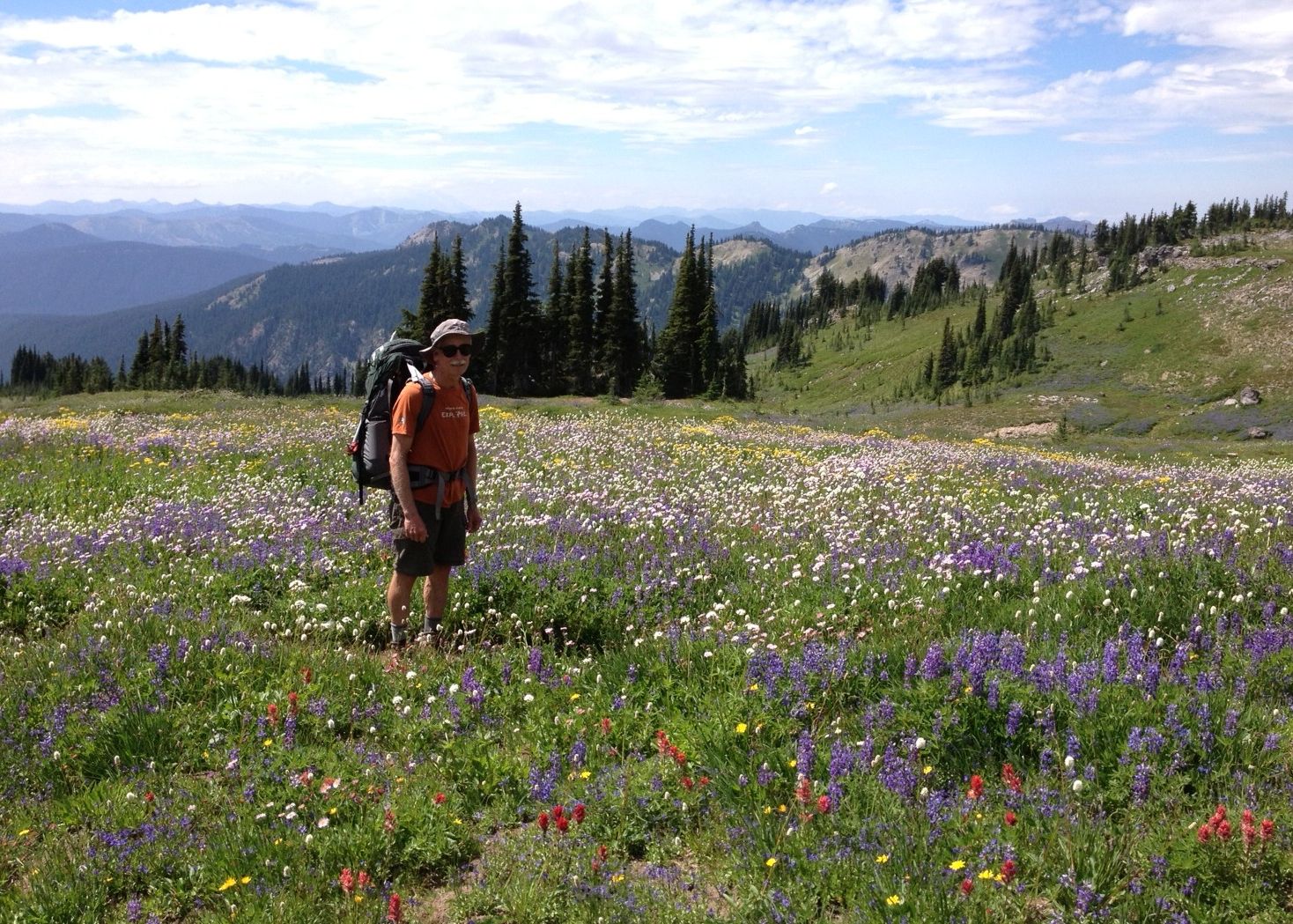
We decide to camp for the first night just west of Old Snowy. Arrived there early enough to still have time to make it over the top of the ridge and down onto the McCall Glacier on the east side, but then we would either have to chop a platform for our tent in the snow, or else drop all the way to the base of the glacier to find a flat spot on the moraine. Seems smarter to stay here, even though it will mean more miles for us to cover tomorrow.
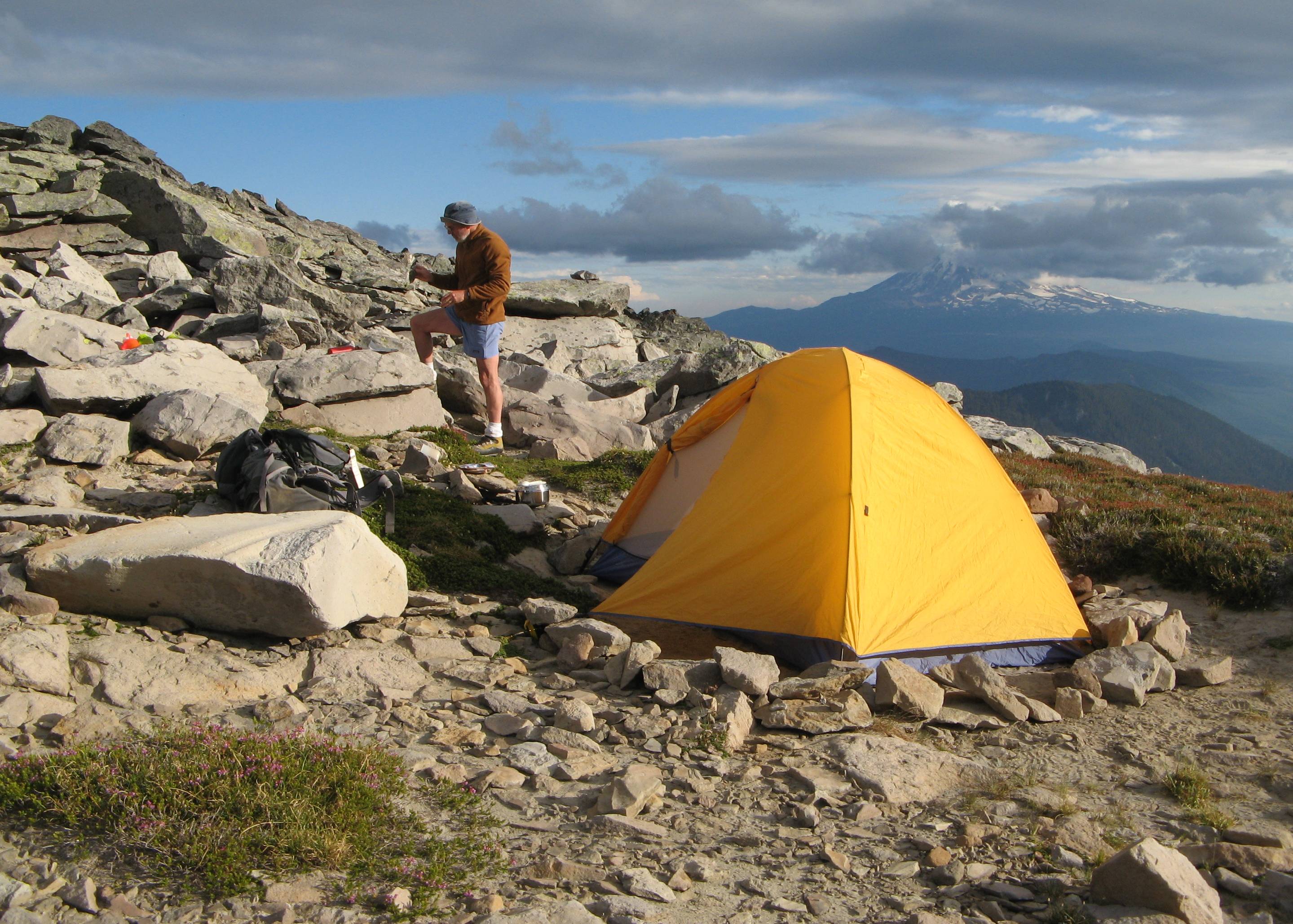
With the tent set up and our sleeping bags and pads in it, we take off at 3:00 PM for a little side hike to the west to visit Goat Lake. Even this late in the year the lake is still mostly covered over with snow. We get back to camp at 5:30, fix dinner, and then turn in for a little star gazing followed by a good night's sleep. There were some clouds today, but Mt. Adams was always visible, as were the peaks of the Goat Rocks, and at times we could also see Mt. Rainier. "Partly cloudy" is what NOAA forecast for today and tomorrow, with Sunday predicted to be clear. It looks like the weather will be in our favor.
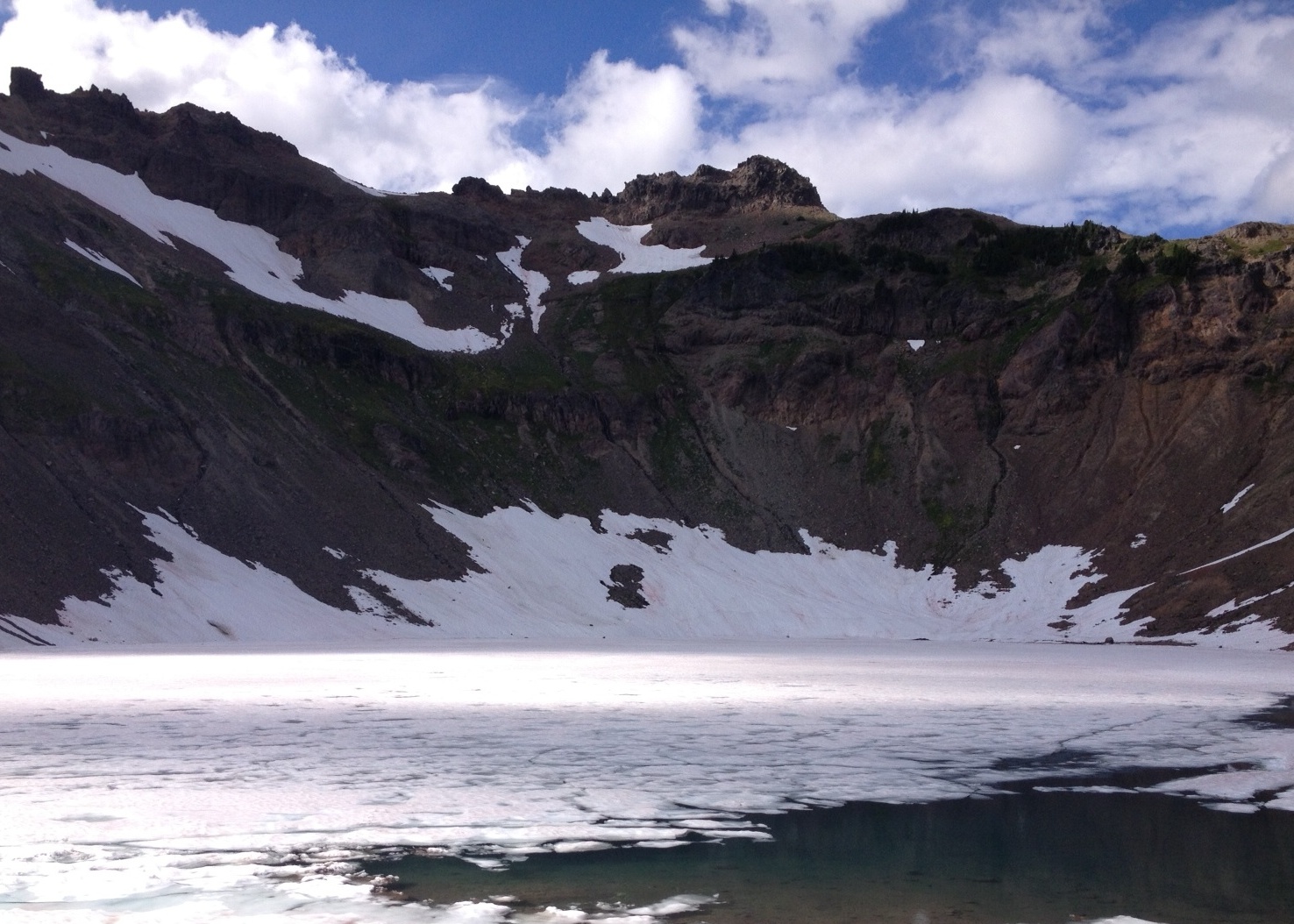
Saturday, 8/17/2013: There were lots of stars out last night but it's cloudier and cooler this morning. Had a breakfast of oatmeal, raisins, and brown sugar with coffee. Packed everything up, threw it on our backs, and headed up to the summit of Old Snowy, with the clouds growing heavier as we walked. Fairly breezy and pretty well socked in at the summit of Old Snowy - could only get occasional glimpses of the snowfields of the McCall Glacier below us on the east side.
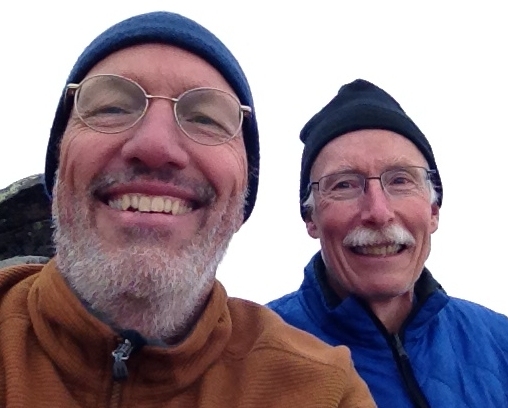
We sheltered out of the wind behind some rocks just a few feet below the summit, waiting for things to clear. At 10:30 AM, after an hour of waiting, we decided that it was too risky to try to traverse across the McCall Glacier in such poor visitility. Too easy to get down there and find ourselves stuck behind some crevase or cliff band, then have to retreat and try to find a way around while making our way by compass. Easily possible to burn up hours in that fashion while making very little progress, only to have to back out by following our tracks back to Old Snowy.
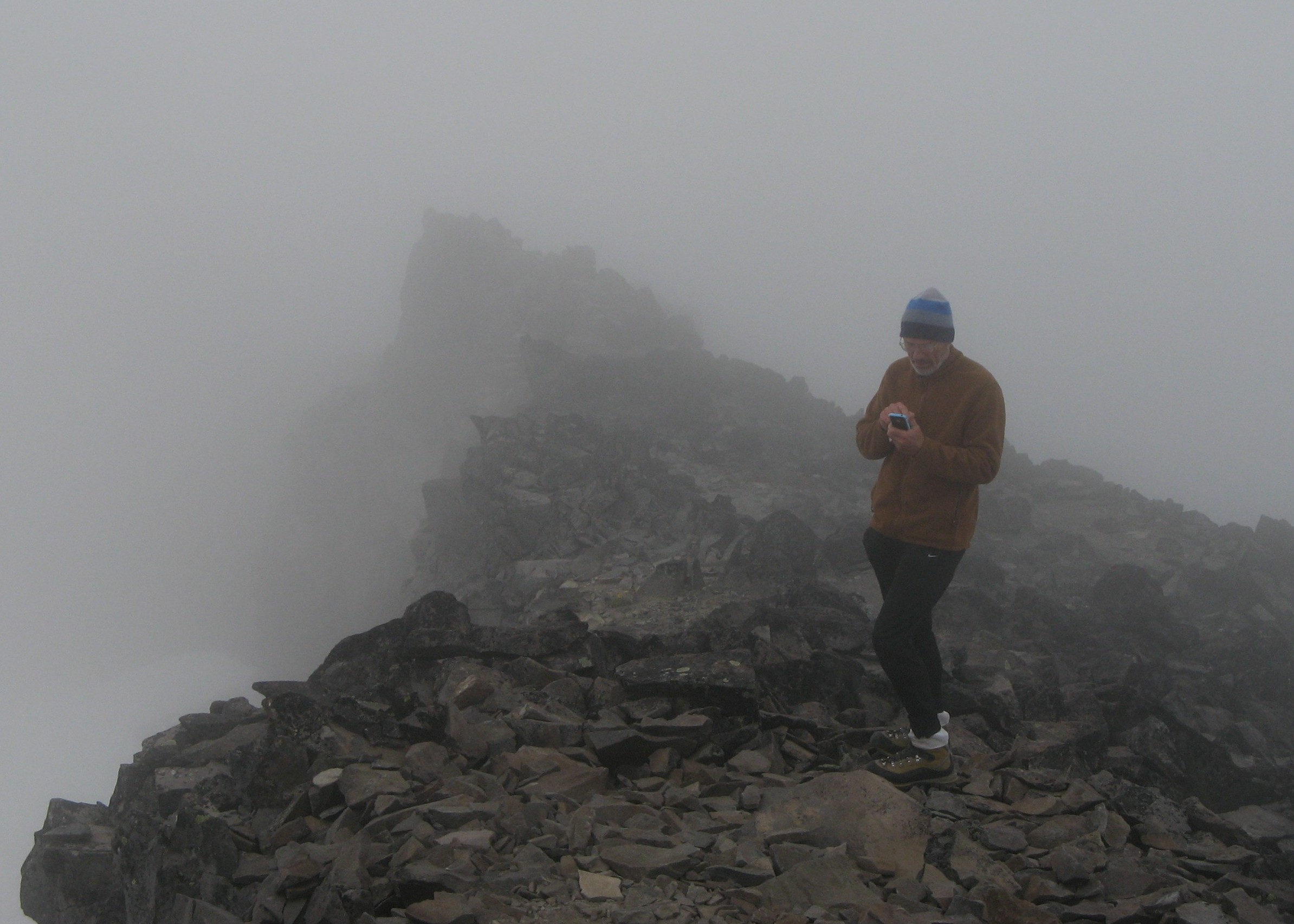
Instead we formulated a Plan B: (1) abandon the idea of looping around the east side of the Goat Rocks Crest, (2) instead, double back toward Snowgrass Flats and then continue south along the Pacific Crest Trail to Cispus Basin and camp there the second night, then (3) on Sunday morning climb Mt. Gilbert from the northwest, ascending below Goat Citadel to a point just north of Mt. Gilbert and then climbing to its summit.
Saturday, 8/17/2013, 1:00 PM: We're at the junction of the PCT and Trail #96, which drops down to Snowgrass Flats and is the trail on which we hiked in yesterday.
Saturday, 8/17/2013, 2:00 PM: We reach an overlook of Cispus Basin. Beautiful! It's as green and thick with wildflowers as Snowgrass Flats, but crisscrossed with streams and little waterfalls, and above the basin are the spires of the central Goat Rocks.
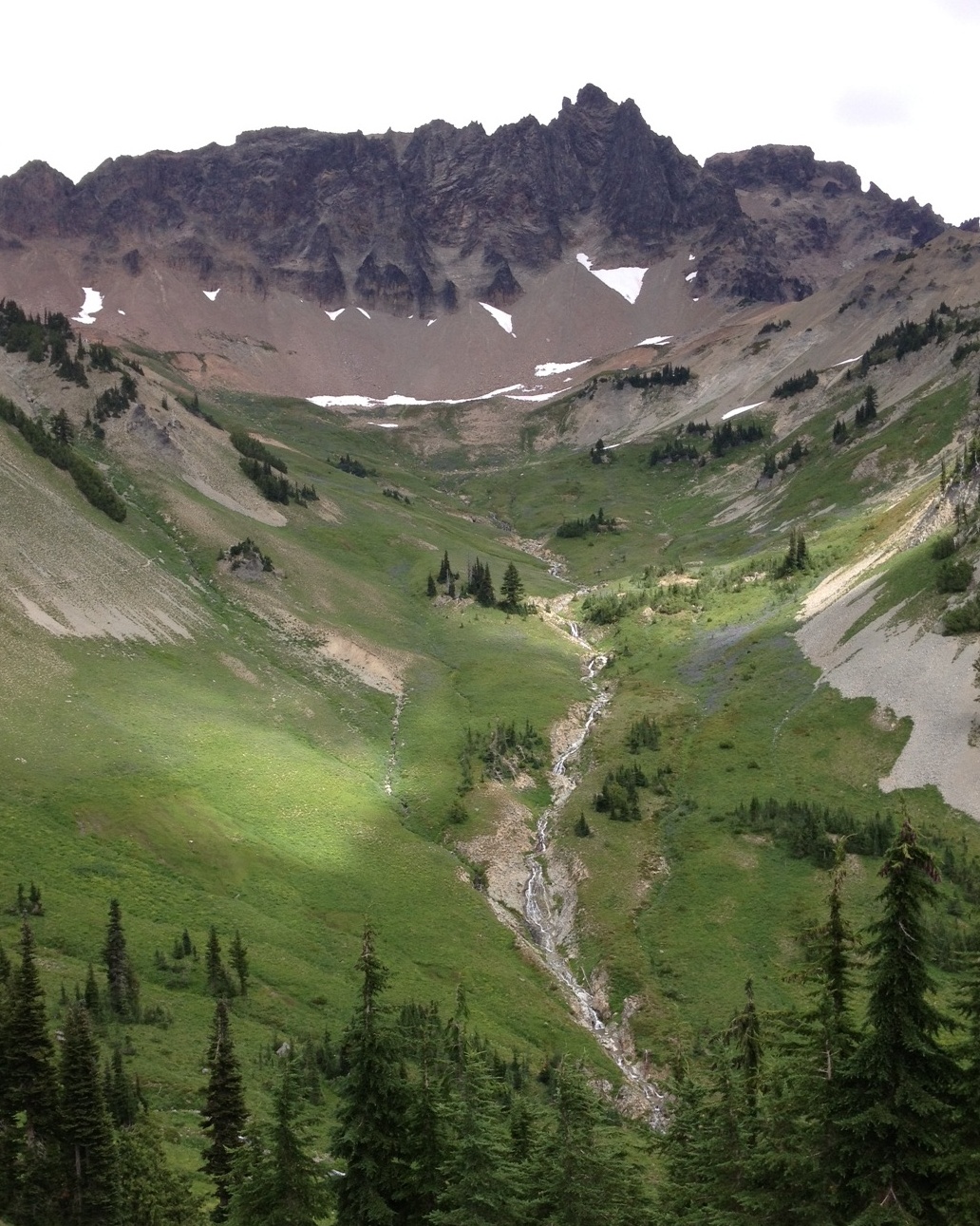
Saturday, 8/17/2013, 3:00 PM: Found a campsite a bit east of where the PCT swings to the southwest and goes up and over Cispus Pass. After setting up the tent, Craig goes for a walk to photograph wildflowers while I sit and gaze up at the huge, gnarled mass of rock that forms Goat Citadel, Big Horn, Black Thumb, and the other spires of the central section of the Goat Rocks Crest.
We've met several Pacific Coast Trail through hikers so far. Yesterday we talked with a bearded guy just above Snowgrass Flats who appeard to be in his 50's and was doing the PCT (at least most of it) for the third time. He said his first trip he did the entire trail, but now he skips the first 700 miles between the Mexican border and central California because it's less interesting. I asked him about finding water on that southern section. He said water is an issue through there, and that the most water he had to carry was seven liters (which is about 14 pounds) through one long, dry section. He said that volunteers and PCT enthusiasts in southern California haul water in to caches at strategic points on the PCT, but that you can't absolutely count on finding water at them when you happen to come through. He said the most water he ever carries in Oregon and Washington is two bottles because streams are so plentiful in the Northwest.
And early this morning just below Old Snowy we met a young woman who was headed south. Felt bad that she would be in fog and unable to appreciate the stunning views along the "Knife Edge", which is known as one of the most beautiful sections of the entire trail. She said she's going to meet up with a couple other PCT hikers at White Pass and they're going to rent a hotel room and treat themselves to hot showers before continuing north. We also met a young couple there that were going the oposite direction, from north to south, doing the section from the Canadian border to the Columbia River. And just before reaching Cispus Basin we met a couple that were doing the entire PCT the usual way, from south to north. We've noticed a remarkable number of women on the trail, and wonder if it isn't due to the novel "Wild: From Lost to Found on the Pacific Crest Trail" by Cheryl Strayed, which has been on best-seller lists for the past year. We also saw quite a few kids headed for Snowgrass Flats on the trail yesterday morning. These are all good signs for the future of hiking!
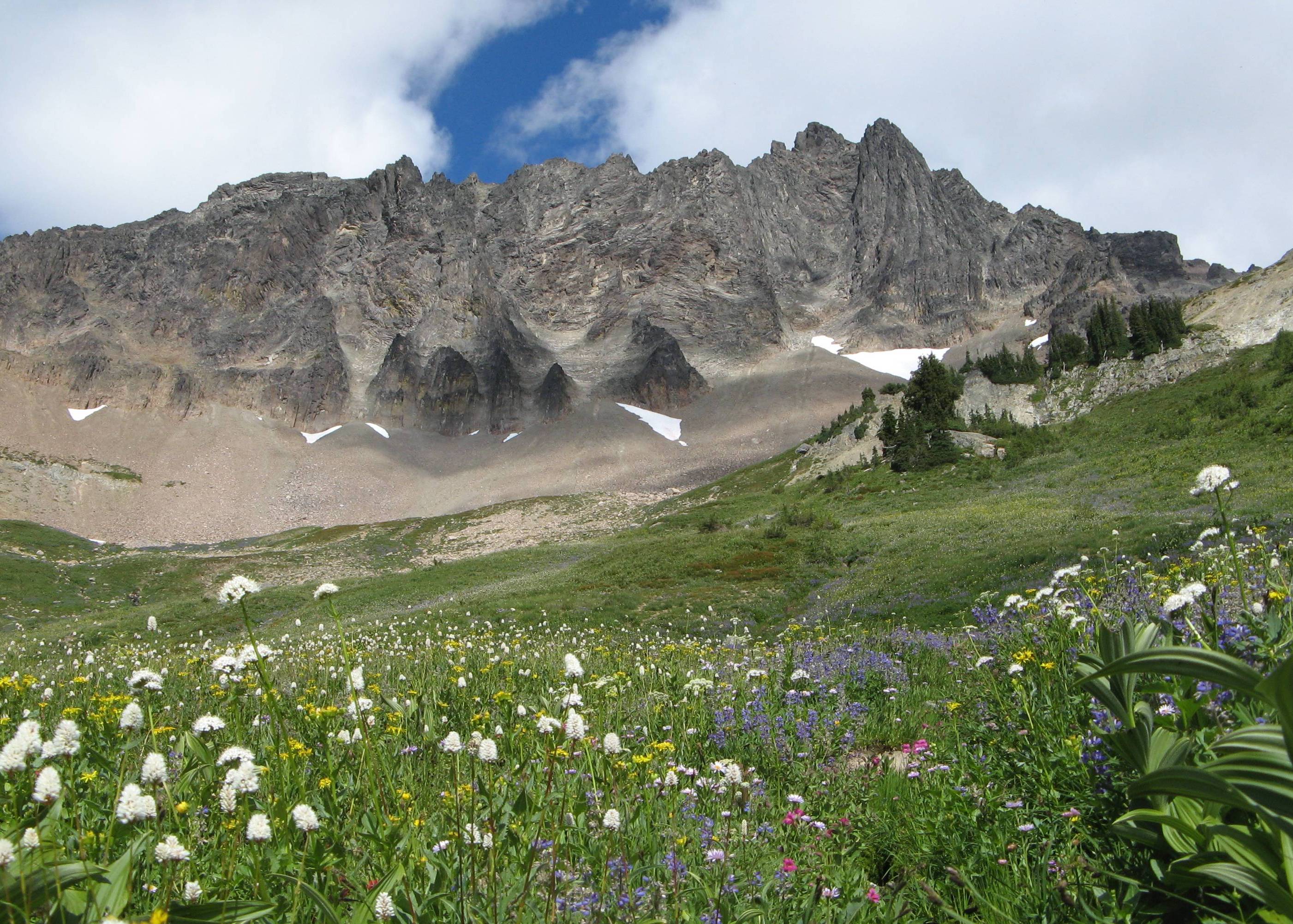
After dinner I sit and watch the line of shadow cast by the setting sun slowly make its way up Cispus Basin toward the rocky spires above. Finding our way up through that maze of cliff bands and gullies up there in the morning will be the big challenge of this trip, but with Craig leading the way I'm not worried at all! After sunset, as we were starting to get ready for bed, the people camping next to us invited us over to their campfire. It was two couples from Portland, with which we ended up sharing a couple of hours of great conversation while dodging the campfire smoke and enjoying the stars twinkling above.
One of the two guys was a freelance graphic artist who took a break from work several years back to hike the Pacific Crest Trail solo. His girl friend works at Nike in sportswear product management, which means she does a lot of scheduling. She and I shared stories about the difficulty of interpreting data flowing between disparate systems and of making sense of historical financial data. It seems that at Nike, and probably any other large company that's been around more than ten years, one fights the same battles that I fight daily at Boeing. This part of the conversation left me with the comforting feeling that there's a plenty big market in the world for my data wrestling skills.
The other woman teaches a combined 1st/2nd/3rd Grade classroom at a Montesori school. (I can't even imagine how that can work, and I would really like to be a fly in the wall in such a classroom!) Her fella, Adam, introduced himself as a commercial fisherman, working the salmon fishery on Bristol Bay about six weeks out of the year and also spending three or four months a year in a fishery (I forget the species) on the Great Salt Lake. He noted that his current situation had evolved from job he had leading climbing parties in the Andes for an outfit named Mountain Madness. It turned out that he and Craig have climbed (or attempted to climb) many of the same peaks in South America. As the two of them talked it was fun to listen to them rattle off the names of peaks in Peru and compare their climbing experiences, which were separated by four decades. Craig did his climbing down there in the 1970's, while Adam was climbing pretty recent. The six of us had quite a wonderful conversation around the campfire, during which I got to hear some great stories of Craig's early climbing days.
Sunday, 8/18/2013: Up at 5:30 AM, fixed oatmeal and coffee for breakfast, and were on our way at 7:00 AM.
Sunday, 8/18/2013, 8:00: Over the Cispus Pass ridge, up the "broad rotten gully" described in Becky's Cascade Alpine Guide, then traversing to the right we cross the first small stream-waterfall. We're following a gray-colored band of rock that angles diagonally upward and to the right (south).
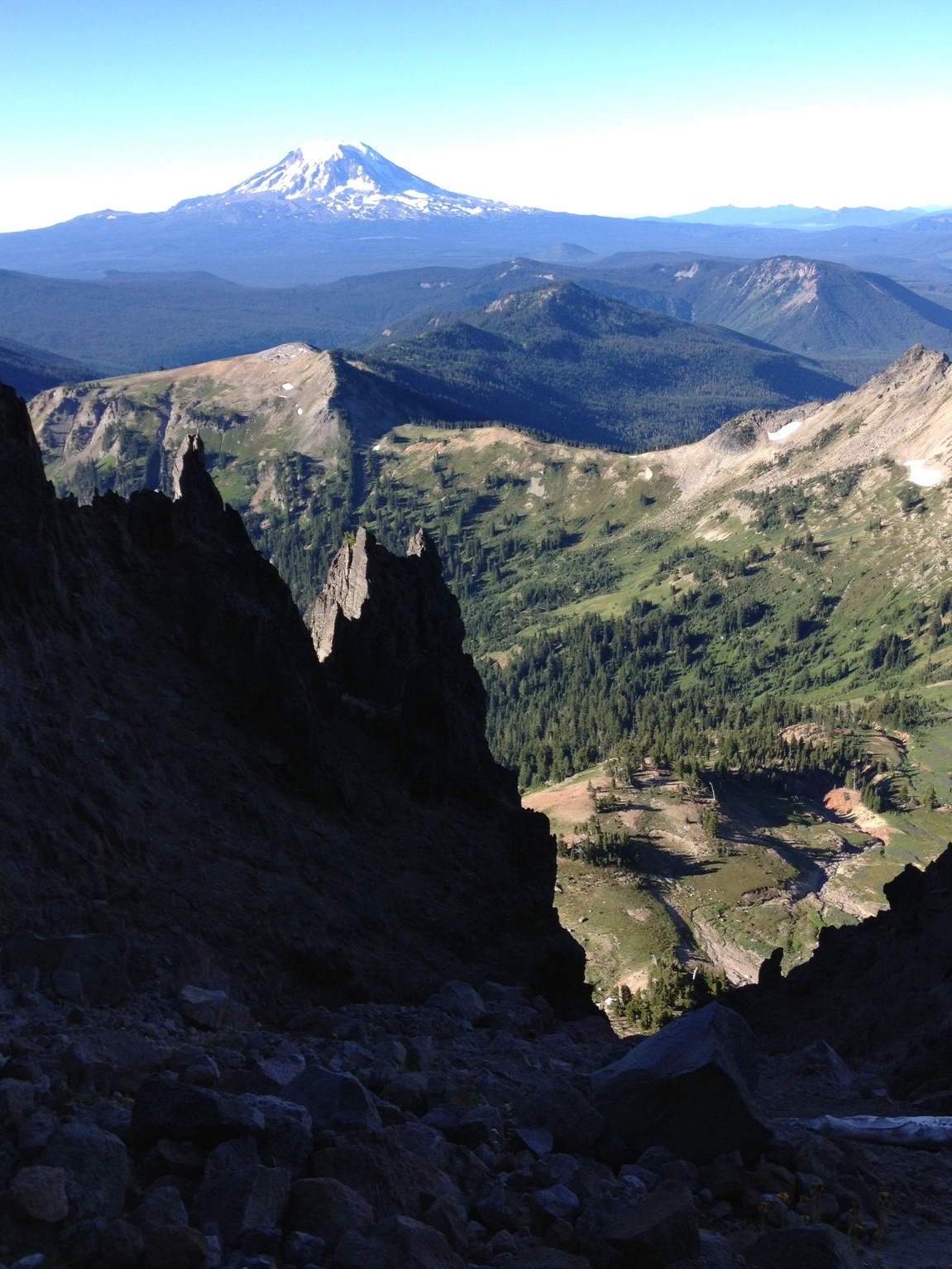
Sunday, 8/18/2013, 9:00 AM: We're at the bottom of a second gully with a little stream in it, having descended a short way next to a small snow field. Craig favors a path upward from here that's farther to the right, while I find solid footing right in the thin stream of water running down the middle of the gully. Craig sees a sling above him and to the right, which suggest a way to ascend, but we don't have a rope with us so we might not be able to descend by that route. We decide to proceed up the gully instead.
Sunday, 8/18/2013, 9:30 AM:At the top of the gully.
Sunday, 8/18/2013, 10:00 AM: At the base of Goat Citadel.
Sunday, 8/18/2013, 10:40 AM:At the summit of Mt. Gilbert. We spend about 20 minutes enjoying the view of Mt. Adams to the south, Mt. St. Helens to the west, and Mt. Rainier to the north.
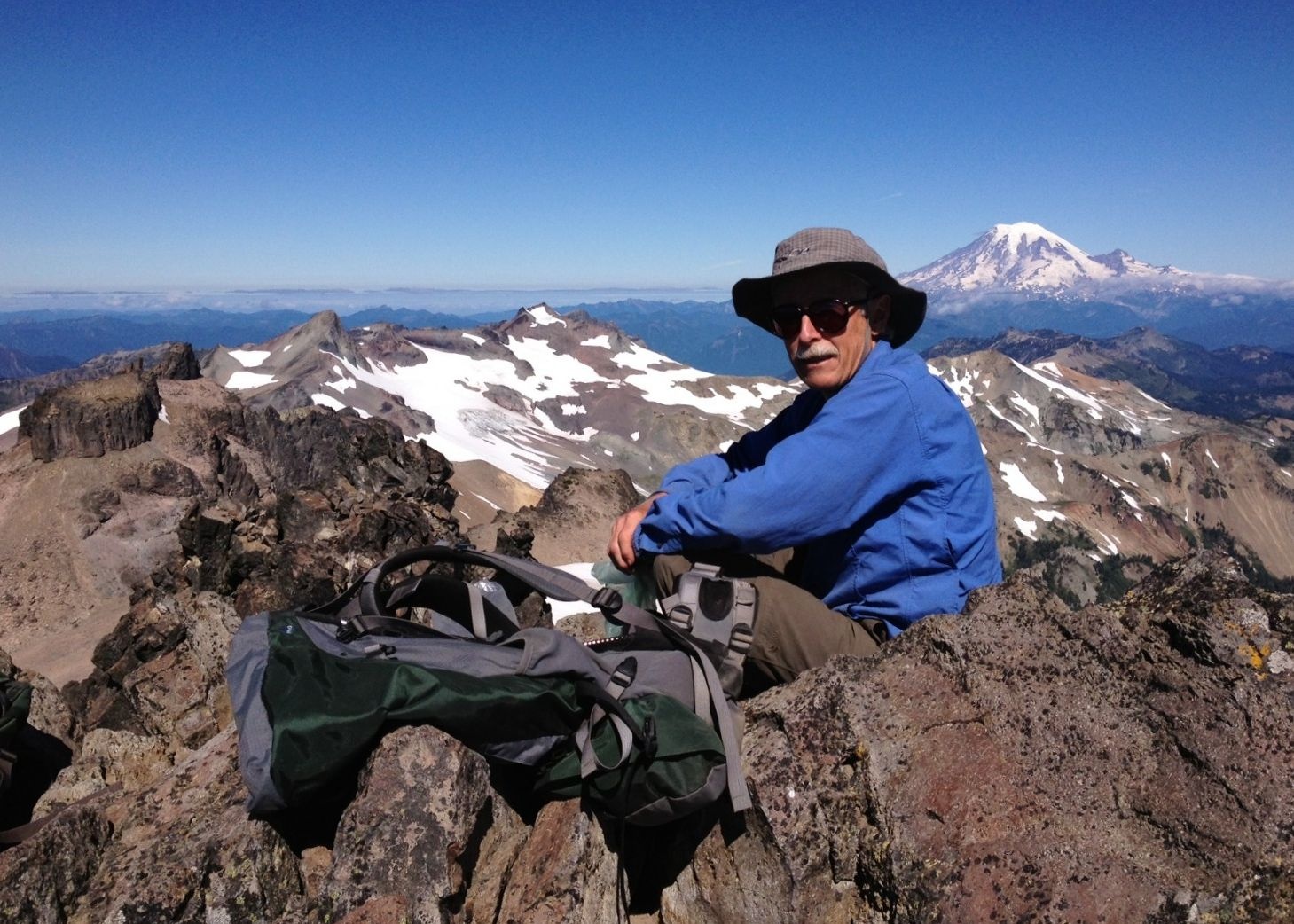
What we've been doing today is usually called "scrambling". None of it's steep enough to call for a rope, however it is steep enough that a fall could result in a bad knock on the head or a twisted ankle. This rock is pretty crummy and the footing is mostly poor, with sand and pebbles scattered on top of small, loose rocks, which sit on top of larger, possibly-loose rocks. So the going is pretty slow, both ascending and descending. When a gully is steep and narrow, Craig descends first while I wait for him to find a spot where he can step out of the fall line and/or shelter behind a boulder. He calls up when he's out of harm's way, and I take my turn. Then if I knock a rock loose on my way down it falls past him, rather than on him.
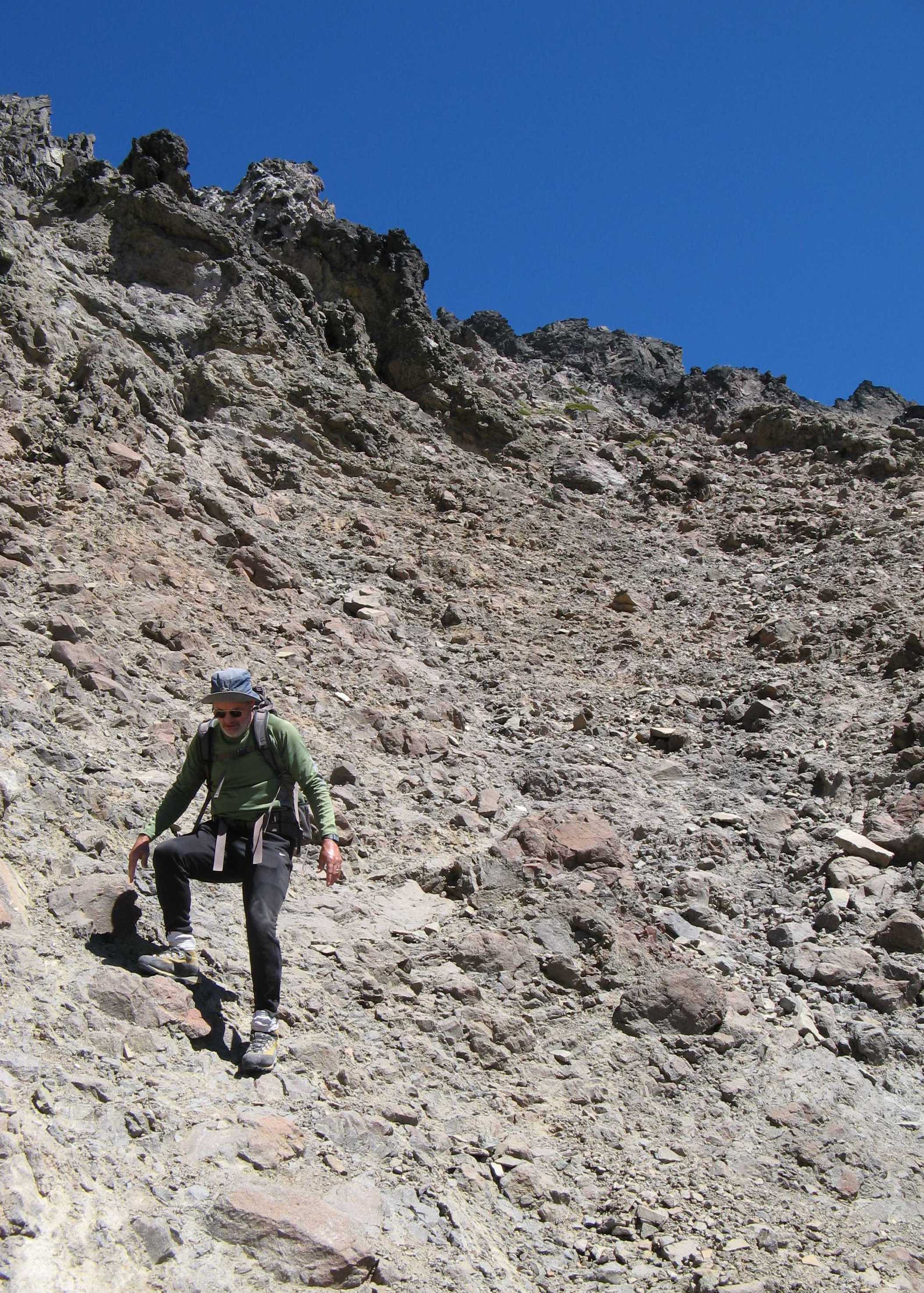
Sunday, 8/18/2013, 2:00 PM: We're back at our tent near the top of Cispus Basin.
Sunday, 8/18/2013, 3:00 PM: All packed up and on our way back toward the car on the PCT.
Sunday, 8/18/2013, 6:00 PM: We're back at the car, having stopped for a nice (but cold!) swim just below the footbridge that's an hour above the parking lot. There's a nice, deep pool there and it's a great spot to wash off the dust and sweat, and to soothe legs and feet that have grown a tired on the trail.
This has seemed like an especially wonderful backpacking trip and I think there are a couple reasons. First, how many people get to spend three days in the mountains with Craig McKibben? Meeting Craig and getting to work with him, first at Western Data and then at WRQ where he was my manager for over a decade, was one of the great breaks of my entire life. Getting to share his company this weekend in the mountains, which he loves so much, has been a special treat. Second, having some adverse weather and route finding problems to overcome made things more interesting. Talking through the decision making processes (How hard would it be to find our way back through the fog on the glacier? If this gully leads to a dead end then what will we try next?) with Craig, who's done a ton of serious mountaineering in his life, gave me some insight into the way that real climbers think through real climbing problems. And third, it's just breathtakingly beautiful in the Goat Rocks and Cispus Basin has been a wonderful new discovery.
After two days up here you find yourself just gazing in quiet awe at what's around you, so absorbed in the here and now that all the cares of life back in "civilization" melt away.